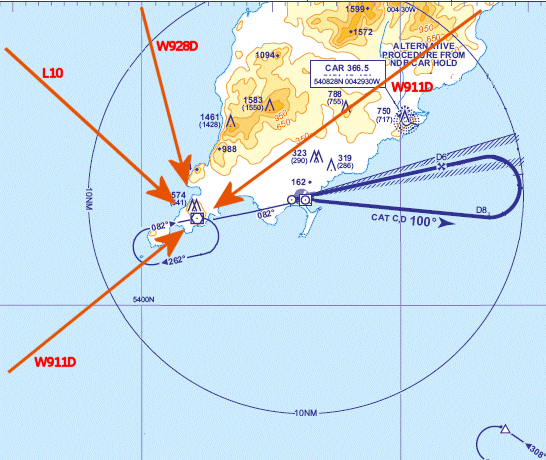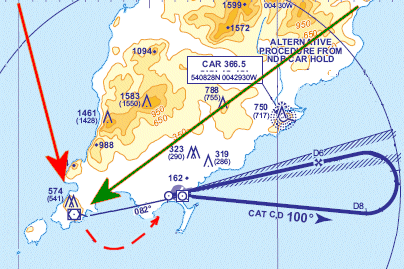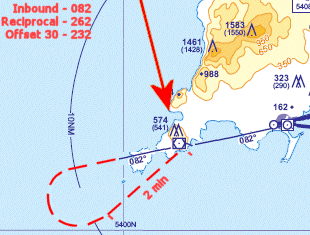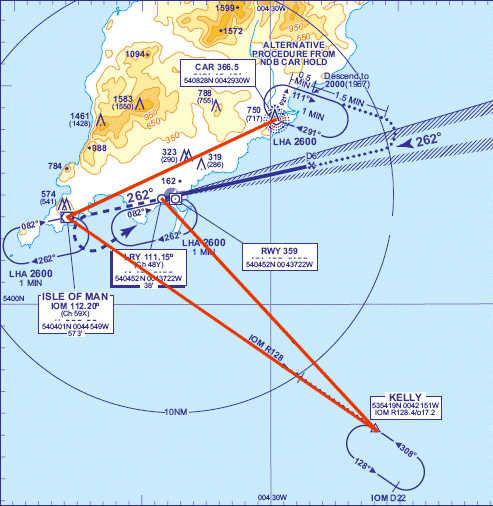






Procedural Instrument Approaches
Part 3
Starting the Procedure
For many procedures the starting point of the IAP is a holding pattern. This makes sense as the stack is the point at which aircraft may be placed in a queue for the approach. It is also important to note that once in the stack the aircraft are flying the correct headings to begin the procedure - the inbound heading of the hold allowing continuation directly into the IAP.
Not all aircraft will hold before making an approach. If there are no aircraft ahead the aircraft will be cleared directly into the procedure - but it could be approaching the fix from a direction which makes it impossible to establish on the correct inbound heading.
Let us look at the ILS approach from IOM VOR as an example. In the diagram below only the IOM procedure is shown for clarity.

You already know the procedure from the IOM - tracking 082 to RWY at 3000ft to start the outbound leg on 100 (if Cat C or D). Aircraft in the hold can do this easily because they are already running inbound to the VOR on this heading. Aircraft which are not in the hold could be approaching the IOM from very different directions - and this can make it impossible to start the procedure directly.
You can see from the above chart that aircraft can approach the IOM from four airways. Whilst aircraft from BEL or DUB could start the IAP directly (as the turn over the IOM towards RWY is not excessive) this is not possible for aircraft from BLACA (on W928D) or from DCS (on W911D) as the turn would be to great - see below.

For the aircraft on W928D any turn towards the RWY would take it well south of the track to RWY and the aircraft would be in an impossible position to fly the rest of the procedure. The same would apply to aircraft from DCS flying the route marked by the green arrow.
The correct entry into the procedure is to ensure you are established on a sympathetic heading towards the VOR before tracking to the RWY. This involves flying a pattern known as a teardrop.
Teardrop Procedure
The teardrop is a pattern the pilot has to calculate - it isn't written in the books. It's purpose is to put the aircraft on an inbound heading to the point at which the procedure starts - in this case towards the IOM VOR on a heading of 082. This is what it would look like.

The basic teardrop involves flying away from the facility at 30 degrees off the outbound heading for two minutes - and then a rate 1 turn to the right back to the beacon.
In the example above the aircraft needs to fly outbound on 232. Should the aircraft have been approaching from the south (say from KELLY) then an outbound heading of 292 would be the correct heading with a left turn back to the beacon.
This procedure isn't meant to be precise (but more skilled pilots can make it so) but it will bring you back to the beacon on a heading that makes the rest of the IAP less traumatic.
Further examples
Let us look back at the I/R Route from the previous page.

You may now see that two teardrops are needed here. The first is when the aircraft reaches KELLY and has to almost reverse course to fly the 308 radial to the IOM. In this case 308-180(reciprocal) = 128 + 30 (offset) = 158. So here you would fly 158 for two minutes and turn left back to KELLY, hopefully on 308 ready for the track towards the IOM.
Again at IOM a teardrop would help establish on the track towards CAR NDB. Here the track isn't published on the IAP and so your would have to work out the headings from your flight log. Roughly from memory you would fly out on 285 to turn left and track in on 075.
A teardrop is a very useful procedure and you can use it at any navaid or fix to leave that point on a specific heading. To some extent it has been replaced by GPS and FMS but it is a skill that is well worth learning.
Holding Patterns
Everyone hates these but they aren't so difficult if you have learned the above skills. Click on Next below for the last tutorial.

